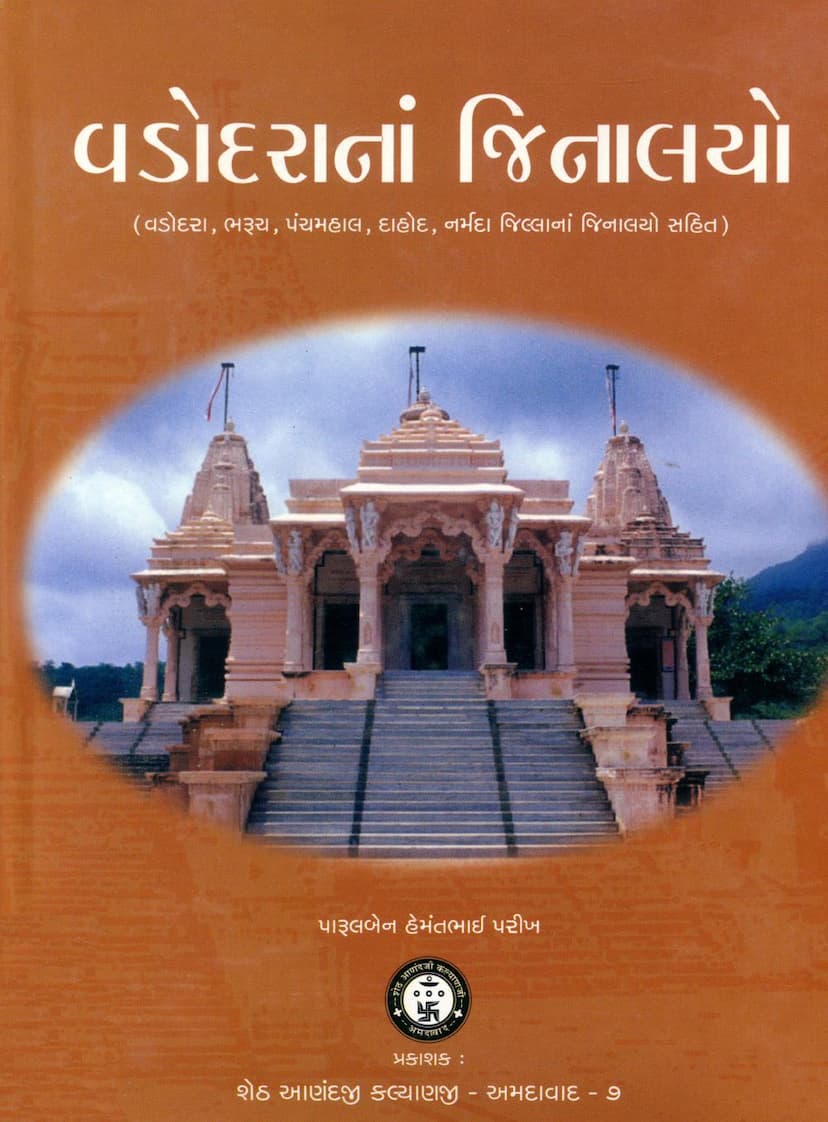Vadodarana Jinalyo
Added to library: September 2, 2025
Loading image...

Summary
The book "Vadodarana Jinalyo" (Temples of Vadodara) by Parulben H. Parikh, published by Anandji Kalyanji Pedhi, is a comprehensive guide to Jain temples in Vadodara and surrounding districts, including Bharuch, Panchmahal, Dahod, and Narmada.
Key aspects of the book include:
- Scope: The book covers Jain temples not only in Vadodara city but also in various villages and towns within the Vadodara district and the districts of Bharuch, Panchmahal, Dahod, and Narmada.
- Objective: The primary goal of this publication is to preserve the history and architectural details of these Jain temples for future generations. It aims to provide detailed information about each temple, including its history, architecture, key idols, inscriptions, and any significant events associated with it.
- Context: The publication is part of a larger plan by the Anandji Kalyanji Pedhi to document Jain pilgrimage sites and temples across India. This initiative began with books on temples in Rajnagar (Ahmedabad), followed by Khambhat, Patan, and Surat. This book on Vadodara and its surrounding areas is the fifth in this series.
- Content Organization: The book is structured to provide a detailed overview. It includes:
- Historical Background: The Jain traditions of Vadodara and Bharuch are discussed, tracing their origins and development.
- Temple Descriptions: Detailed descriptions of temples in Vadodara city, Vadodara district, Bharuch district, Panchmahal district, Dahod district, and Narmada district.
- Appendices: The book includes tables listing the temples by sequence, district, and by Tirthankara (Jain spiritual leaders). It also contains lists of Upashrayas (monastic residences), Pathshalas (schools), Gyan Bhandars (libraries), Ayambilshalas (places for fasting rituals), Dharmashalas (rest houses), Bhojanshalas (dining halls), and various Jain Sanghas (communities).
- Chronological Information: Appendices provide a timeline of Jain events in Vadodara and Bharuch, as well as a Ghazal about Vadodara by Kavi Shree Deepvijayji.
- Photographic Documentation: The book includes photographs of various temples and their architectural details, highlighting the craftsmanship and artistic elements.
- Methodology: The information was gathered through extensive field research, including direct visits to the temples. The author and her team meticulously collected details, ensuring accuracy and capturing even the smallest aspects of the temples, while adhering to Jain scriptural rules and practicing devotion. The book acknowledges the challenges faced during data collection, such as communal unrest and initial skepticism from some trustees, but praises the patience and leadership that ensured the project's success.
- Historical Significance: The book highlights the rich Jain heritage in Gujarat, referencing influential Acharyas (religious leaders) and ministers who patronized Jainism. It notes the presence of significant Jain pilgrimage sites like Shatrunjaya, Urjayanta Giri, and Taranga Tirth within Gujarat.
- Specific Details: The book provides counts of temples in various districts: 13 in Bharuch city, 68 in Vadodara city, 34 in Bharuch district, 74 in Vadodara district, 27 in Panchmahal district, 8 in Dahod district, and 4 in Narmada district. It also mentions that certain important temples like those in Bharuch (Ashvavbodh Tirth), Kavi, Gandhar, and Jhagadia, as well as prominent temples in Vadodara like Sumeru Tirth and Pavagadh, will have separate booklets published later.
- Artistry and Architecture: The temples in Vadodara, while perhaps not possessing the grand architectural uniqueness of Khambhat or Patan, showcase a blend of ancient artistry and modern construction styles. The book notes the intricate carvings and detailed craftsmanship found in many temples, even in smaller villages.
- Data Presentation: The book includes tables detailing the number of statues (pratimas) and painted scrolls (pat). It clarifies the methodology for counting statues, excluding those of guardian deities and monks, and defines what constitutes a 'pat'. The dating of temples relies heavily on inscriptions on the main idols, with noted difficulties where inscriptions are missing or illegible. Reference is also made to secondary sources like the Jain Shwetambar Directory and Jain Tirth Sarva Sangrah.
- Dedication: The book is dedicated to preserving the legacy of Jainism and inspiring future generations. It emphasizes the importance of maintaining these sacred sites and passing down their history.
- Author's Effort: The preface and introduction highlight the immense effort, dedication, and meticulous research undertaken by Parulben Parikh and her team of women collaborators, who personally visited numerous villages to gather information.
In essence, "Vadodarana Jinalyo" is a valuable resource for anyone interested in the history, architecture, and cultural significance of Jain temples in the specified regions of Gujarat, meticulously compiled and presented by the Anandji Kalyanji Pedhi.